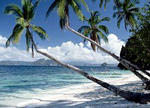|
Saturday, 6 August 2005
 Ranao and Mindayen
Ranao and Mindayen
Now Playing: Ancient deities of the islands

The future reverts back in Princess Ranao and Mindayen’s universe.
So does the belief in ancient gods and goddesses which were once observed throughout the islands.
Before the Muslims and the Spaniards had set foot on Philippine shores, the ancients had their sets of deities and other supernatural beings whom they fear, pray to or worship, and called on their assistance through their walks of life.
The Dictionario Mithologico (Second Edition, 1895) written by Ferdinand Blummentritt, provides a list of unworldly beings respected by various natives.
The Leader God was known by many names, Apu to the Igorots, Banua to the Bataks of Palawan, Kabunian and Lumawig to the tribes of Northern Luzon, Kaptan to the Visayas, Apo Malyari to the Zambal, Mananahahut to the Kiangans and Magnisda to the Tagbanuas. But the leader god was popularly known by his Sanskrit name as Bathala or Bathalang Maykapal.
Creation stories were best attributed to the Leader gods. But the Bagobos tribes believed in the joint venture of three gods:
Makakoret: who created the sky.
Makaponget: who created the waters
Mamale who created land.
The goddess Lalahon was believed to reside in a remote volcano called Malaspina, located somewhere in the islands of Negros.
Sida-pa, another island goddess, was believed to reside on the top of a legendary mountain called Madya-as somewhere in the island of Panay. Legends tell about Sida-pa and her own tree of life. She was said to make notches on the tree that said to regulate the life time of all people.
In agricultural areas, the natives prayed to the gods for good harvest and to protect the fields. For the Tagalogs, Idianale was the god of agriculture and Lakanpati was the protector of their fields.
On the other hand, the Zambals call upon Dumagan and Damolag, before planting thewir crops to protect their fields from storms and typhoons.
The Bagobos tribe calls on Dimakolem, god of the mountains for their well being.
Taguibanua was the agriculture god in some areas in Mindanao while in the Visayas, she was also a goddess for house hold benefactors. Sedumunadok was the god of their planting fields. In the Tagalog fishing villages, they call upon Aman Sinaya for aid. On the other hand, Poko, was the Tagbanua people’s sea god.
In the story of Ranao and Mindayen, the prevalent sea goddess is Abyang Ghinbinitan.
There are also fighting and warrior gods that said to boost moral among different combatants. The tribes of Pangasinan had Apolaki as their war deity. The Visayan people once offered sacrifices to Wataugo for victory in battle.
Deities of welfare also played important roles in ancient Filipino lifestyle. Ang them were Lakambini of the Tagalogs who was said to be giver of food and Lakambakad as healer of sickness. The goddess of love among the Tagalogs was Dian Masalanta.
There were evil gods, said to live in hell-like places for the damned.
The Tagbanuas had Basaud as their hell-like abode, while the Ilocanos had Kasamaan.
The Visayan people called the god of hell, Sumpoy (Siguinaguran or Suinuran) who was aided by his demon armies called Yawa or Panulay.
The gods and goddesses who resides on Eden-like places were the ones worshipped and often called by the natives for help and blessings.
Kadungan was the paradise-like site for some tribes in Northern Luzon. The Bicolanos called such a place as Kamburagan. The Visayans call their paradise as Ologan.
The people of Panay once believed that Paradise was located on top of the mysterious mountain Madya-as. (Something similar to Mount Olympus)
View Latest Entries
|
